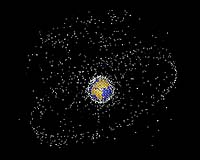 |
Bethesda MD (SPX) Jun 29, 2009 Launchspace is seriously looking at the increasing risk of space debris interfering with operational satellites in a proactive way. Although no one knows when this will turn into a crisis, we do know it will happen, unless the world stops using space applications. But, the benefits of space are simply too important and they have become an integral part of modern living. The options seem obvious. We can anticipate the logical progression of adverse events and plan mitigation and remediation programs, or we can ignore the inevitable and do nothing until access to space is denied to all space-faring nations. In other words, we can expend a low level of resource over a long period of time, or expend a great deal of resources later, after many of our space assets are no longer operational. The new Launchspace series, Trash Talk, is intended to provide our readers with the latest ideas and actions affecting space debris mitigation and remediation. The discussion begins with the beginning of the debris accumulation problem and will continue until much of the actions and ideas that address solutions have been aired. Launchspace welcomes comments from you, our readers. It all started at the dawn of the Space Age on that fateful October day in 1957 with the launch of Sputnik 1. No one had an inkling that the exploration and exploitation of space would eventually lead to the trashing of near-Earth orbits. Nevertheless, as the number of launches increased through the 1960s, expired satellites began to accumulate in a variety of orbits. This rate of satellite launches exceeded 100 per year within 10 years and reached an all-time high of 129 in 1984. Every space launch created some trash in the form of large and small debris objects. Often these consist of upper stages and satellites that cease to operate. Over the years in orbit, many of these break up, explode or are broken up by collisions with other debris. As early as 1970, NASA began funding research activities at Penn State University to investigate ways to remove large expired satellites from orbit. This work addressed the capture of large uncontrolled objects that were spinning or tumbling. Some of the resulting ideas will probably be used when an actual debris reduction program is implemented. Ideas that evolved from this early work were later used to assure the safe reentry of Skylab in 1979. When NASA began internal debris studies in the 1970s there were less than 2000 objects cataloged by NORAD. At that time collision risks were not considered significant except for very large space structures. As the debris population expanded studies were focused on the sources of small debris objects. By 1980, NASA concluded that explosions of Delta second stages and USSR satellite tests were the major contributors to space debris. In 1981, the American Institute of Aeronautics and Astronautics (AIAA) issued a position paper on space debris in which the risk issues of space debris were identified and it called for real action to mitigate future catastrophic collision events. It has been 28 years since the initial alarm was sounded by AIAA. In the interim several mitigating actions have been implemented by space-faring nations. Delta upper stages are prevented from exploding by venting the propellant tanks. Debris shielding has been added to many satellites. Most recently newly launched satellites have the ability to de-orbit at the end-of-life point. There is extensive tracking of debris pieces that are larger than 10 cm, often resulting in avoidance maneuvers by satellites. Nevertheless, the debris problem continues to grow, because the world continues to launch new satellites. Many national and international groups are studying the space debris issue and they are making progress in mitigating future debris. But, a real debris reduction program seems is inevitable. Because of this, we should all be concerned about the future impact of space trash on our ability to use space for human and robotic exploration and exploitation of the final frontier. For all those who are concerned and interested in the pending space debris crisis, your first step is to get smart on the space debris issues and possible solutions. This is where Launchspace can help. If you are involved in space flight, you will want to sign up for "must take" seminar on the subject, August 4 in Washington, DC. Share This Article With Planet Earth
Related Links Launchspace Space Technology News - Applications and Research
 Space Traffic Management In The Earth 21st Century
Space Traffic Management In The Earth 21st CenturyBethesda MD (SPX) Jun 08, 2009 The spacefaring nations of the world are coming to the conclusion that the space debris issue has evolved from a minor nuisance to a full-blown imperative. Hundreds, if not thousands, of decision makers, engineers, managers, politicians and policy makers have focused their attention on how to deal with the fast-growing threat to operational satellites and future access to space. All that ... read more |
|
| The content herein, unless otherwise known to be public domain, are Copyright 1995-2009 - SpaceDaily. AFP and UPI Wire Stories are copyright Agence France-Presse and United Press International. ESA Portal Reports are copyright European Space Agency. All NASA sourced material is public domain. Additional copyrights may apply in whole or part to other bona fide parties. Advertising does not imply endorsement,agreement or approval of any opinions, statements or information provided by SpaceDaily on any Web page published or hosted by SpaceDaily. Privacy Statement |